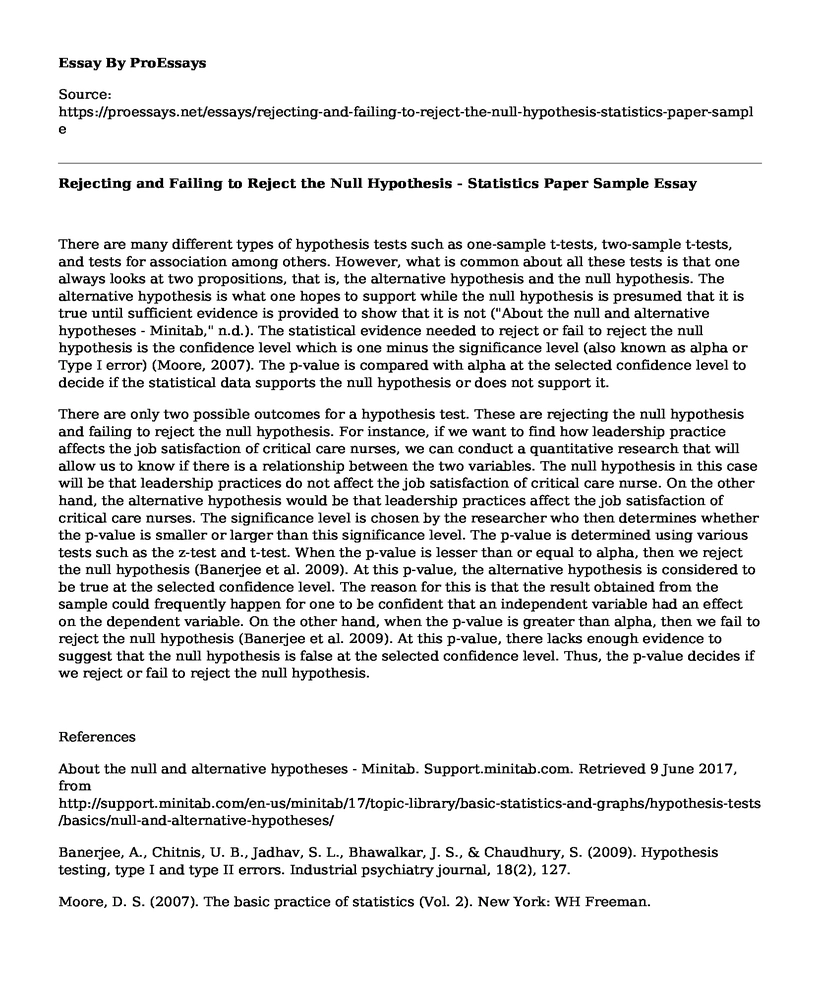There are many different types of hypothesis tests such as one-sample t-tests, two-sample t-tests, and tests for association among others. However, what is common about all these tests is that one always looks at two propositions, that is, the alternative hypothesis and the null hypothesis. The alternative hypothesis is what one hopes to support while the null hypothesis is presumed that it is true until sufficient evidence is provided to show that it is not ("About the null and alternative hypotheses - Minitab," n.d.). The statistical evidence needed to reject or fail to reject the null hypothesis is the confidence level which is one minus the significance level (also known as alpha or Type I error) (Moore, 2007). The p-value is compared with alpha at the selected confidence level to decide if the statistical data supports the null hypothesis or does not support it.
There are only two possible outcomes for a hypothesis test. These are rejecting the null hypothesis and failing to reject the null hypothesis. For instance, if we want to find how leadership practice affects the job satisfaction of critical care nurses, we can conduct a quantitative research that will allow us to know if there is a relationship between the two variables. The null hypothesis in this case will be that leadership practices do not affect the job satisfaction of critical care nurse. On the other hand, the alternative hypothesis would be that leadership practices affect the job satisfaction of critical care nurses. The significance level is chosen by the researcher who then determines whether the p-value is smaller or larger than this significance level. The p-value is determined using various tests such as the z-test and t-test. When the p-value is lesser than or equal to alpha, then we reject the null hypothesis (Banerjee et al. 2009). At this p-value, the alternative hypothesis is considered to be true at the selected confidence level. The reason for this is that the result obtained from the sample could frequently happen for one to be confident that an independent variable had an effect on the dependent variable. On the other hand, when the p-value is greater than alpha, then we fail to reject the null hypothesis (Banerjee et al. 2009). At this p-value, there lacks enough evidence to suggest that the null hypothesis is false at the selected confidence level. Thus, the p-value decides if we reject or fail to reject the null hypothesis.
References
About the null and alternative hypotheses - Minitab. Support.minitab.com. Retrieved 9 June 2017, from http://support.minitab.com/en-us/minitab/17/topic-library/basic-statistics-and-graphs/hypothesis-tests/basics/null-and-alternative-hypotheses/
Banerjee, A., Chitnis, U. B., Jadhav, S. L., Bhawalkar, J. S., & Chaudhury, S. (2009). Hypothesis testing, type I and type II errors. Industrial psychiatry journal, 18(2), 127.
Moore, D. S. (2007). The basic practice of statistics (Vol. 2). New York: WH Freeman.
Cite this page
Rejecting and Failing to Reject the Null Hypothesis - Statistics Paper Sample. (2021, Jun 24). Retrieved from https://proessays.net/essays/rejecting-and-failing-to-reject-the-null-hypothesis-statistics-paper-sample
If you are the original author of this essay and no longer wish to have it published on the ProEssays website, please click below to request its removal:
- Essay Sample on White Collar Crime
- Essay Sample on My Applied Managerial Statistics Experience: From Fear to Surprise
- Westward Academy: Recruiting Resourceful People for Success
- Securing Cyber Data: A Promising Cybersecurity Start-up
- Essay Example on Social Media: A Crucial Part of Life
- Essay Example on Teen Driving: 14% of Accidents Caused by Inexperienced Drivers
- Making Decisions with Data: Understanding Hypothesis Testing & Statistical Significance - Article Review Example







